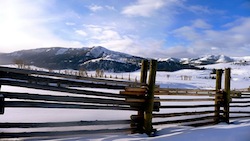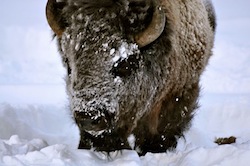
Yellowstone has been a favorite destination for travelers almost since the day it was established back in 1872. As the world's first national park, it set quite a standard for all others that would follow. Boasting more than 2.2 million acres of pristine wilderness Yellowstone stretches across parts of Montana, Wyoming, and Idaho, and is one of the premiere outdoor playgrounds in all of North America.
A visit to Yellowstone is an adventure in any season, but winter adds a whole new dimension to traveling through the park. The region receives plenty of snow each year, averaging 200 inches near Old Faithful and yet more still at higher altitudes. Because of these conditions, the North Entrance, located just outside Gardiner, Montana, is the only gate that remains open year round. Visitors passing through that entrance will gain access not only to the historic Mammoth Hot Springs Hotel, but also the beautiful Lamar Valley, the best place to spot wildlife in the entire park.
Besides the Mammoth Hot Springs Hotel, the only other place for visitors to stay during the winter is the Snow Lodge, located near Old Faithful, the park's famously punctual geyser. If you book accommodations there you'll also need to arrange for transportation, as the lodge is only accessible by snow mobile or snowcoach, a specially-designed vehicle with treads, not unlike those found on a tank, that moves easily through deep snow.
Travelers who do make the journey to the Snow Lodge, will find themselves at the very heart of the geyser basin, where dozens of Yellowstone's legendary geothermal features are prominently on display. The basin is best explored on foot, even during the winter months and it is the perfect place to strap on a pair of snowshoes or cross country skies and hit one of the numerous groomed trails that meander across the region. Those trails offer unprecedented access to the park's best hot springs, mud pots, and geysers, which are just as active in the winter months as they are in the summer.
No matter what season you choose to visit Yellowstone in, the wildlife is always one of the top attractions. But winter affords visitors more opportunities to spot the various creatures that inhabit the park, as the heavy snows force the herds of elk, sheep, and bison to lower altitudes in search of food. The blanket of white snow that covers the area makes it far easier to spot the creatures as well, and those with quick eyes may catch a glimpse of otters, eagles, coyotes, or even the odd fox or two. Extremely lucky visitors may even spy one of Yellowstone's legendary, yet elusive, wolves, which roam throughout the park. Don't expect to come across a bear however, as in the cold winter months they are deep in slumber.
Perhaps the best reason to visit Yellowstone in winter however is for the solitude. As mentioned, the park sees more than 3 million visitors per year, but of those, just 100,000 arrive during the winter months. With so few travelers in such a massive area, you're likely to have the trails completely to yourself and it is possible to go for hours without seeing another living soul. The quiet of the wilderness can be deafening, but it provides for moments of introspection that few other places can inspire.
Winter can be a harsh season. It is cold and the freezing winds can bite hard. But in a place like Yellowstone, winter's true beauty can be found, and a landscape that is already spectacular, becomes a master work of art that is well worth witnessing first hand. And even if you've been to Yellowstone before, if you haven't seen it covered in snow, you haven't really experienced it at all.
